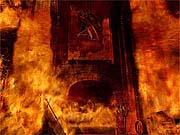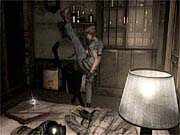Resident Evil Preview
We've gathered all the info currently available on the upcoming GameCube version of Resident Evil. Become informed.

Capcom has always been a very high-profile company, closely associated with such classic series as Mega Man, Strider, Ghosts 'N Goblins, and Street Fighter II. In more recent gaming history, the venerable publisher has made a splash with the Resident Evil series. But let's step back a couple of years, to the early days of the PlayStation, when Sony was still a newcomer in the gaming industry. One of Capcom's internal development teams, led by Shinji Mikami, was asked to develop an action-adventure game for Sony's console. The team was pretty much given total artistic and creative freedom, and there really wasn't much pressure for them to make the game a smash hit. Inspired by their previous work in the game Sweet Home--a horror adventure game released on the Famicom in 1989--their focus for the project was the same: horror and adventure. The result was Resident Evil, which was released on the PlayStation in 1996. To everyone's surprise--including Capcom's--the game eventually became a hit on Sony's console, and the rest is history.
Three sequels and numerous spin-offs have been released on multiple consoles over the years, and the anticipation for the latest Resident Evil has been very high among the gaming community. In 1999, Capcom announced Resident Evil Zero for the Nintendo 64 and Resident Evil 4 for the PlayStation 2. A year later, the company announced that the development of Resident Evil Zero had shifted onto the GameCube. Meanwhile, the supposed Resident Evil 4 for the PS2, under the direction of Hideki Kamiya, ultimately became something entirely different--Devil May Cry. And then came some shocking news: In the midst of announcing that the Resident Evil series would be exclusive to the GameCube, Capcom revealed that it planned to release of a remake of the original Resident Evil. The company would then release Resident Evil Zero, ports of Resident Evil 2, Resident Evil 3, and Code: Veronica, and the all-new Resident Evil 4. The creator of the series, Shinji Mikami, took the helm as the director once again, and he promised to take the survival-horror genre to a new level of "raw" realism.
Remaking a classic is certainly a challenge. While a majority of the game environments will make use of prerendered backgrounds (as opposed to a fully 3D polygonal ones), certain parts will make use of CG movie backgrounds. Mikami and his team have been performing a series of experiments with the use of full-motion backgrounds, and samples of that work has been shown on the official Web site--you'll surely remember the room engulfed in flames, or the scene where water is dripping down the stairwell. These are scenes created to demonstrate what can be done, though they won't necessarily be used in the game itself. Some effects that definitely won't make it into the game were shown on the Web site as well, such the zombie with the exploding head, the water gushing through the corridor, and the scene with Chris using the flamethrower.
In creating the models for Jill Valentine and Chris Redfield, Capcom auditioned actors to be used as a reference by the character designers. The audition was not to promote any particular celebrity (unlike with Onimusha), however, so no popular actors were selected. About 60 percent of the characters' motions were animated based on motion-capture data, which was subsequently manually tweaked, while the rest was created from scratch. To demonstrate the grade of motion capture, Capcom has shown us screenshots in which Jill is performing flying kicks and punches. Unfortunately, players won't be able to perform these actions in the game--they were simply rendered for illustrative purposes. Lastly, Soundelux Hollywood--known for its work in films such as Braveheart, Face/Off, and Cliffhanger--was hired to help with the game's sound production. Capcom worked closely with the studio previously on Devil May Cry for the PlayStation 2. And although the Japanese subtitles will not see much change, the English dialogues will be redone completely with new voice talents.

Although the GameCube version is a remake of the PlayStation original, you could really consider it a new game altogether. Capcom has planned major changes in the item and enemy placements, as well as the interiors of the mansion. The layouts of some of the familiar rooms will be changed, and you can even expect new rooms that weren't present in the original. There will even be new areas located outside the mansion as well. Enemies might appear in rooms that were previously empty, and some may even smash the doors open and suddenly attack you, seemingly to punish you for being cocky enough to feel at home in this new place. In addition to these changes, the camera will be more dynamic, and varying angles will be used to enhance the details on some of the larger environments. We'll still be seeing some load times in between rooms (with the old-fashioned "opening door" sequence), but other mechanics have become more efficient, like climbing up the stairs. In terms of gameplay, playing as Chris or Jill will now involve roughly the same level of difficulty, although the style of gameplay will vary between the two. While Chris can be more aggressive against some of the enemies, you'll have to more careful when playing with Jill. She's more flexible since she can carry more items and unlock doors, but you'll have to avoid confrontation as much as possible.

Capcom is also expected to include new elements in the gameplay, though details are still scarce. For example, when you aim at a zombie's head and shoot the shotgun, it does not necessarily blow the head off at all time. There will also be new items like a bottled fuel container, which may be used in possible key events or puzzles in the game. The green, blue, and red herbs will still serve the same function, although a random factor is now involved when your health has dropped into the "danger" state. Depending upon luck, your health may replenish greater or lesser when you use the green herb or a combined herb with healing effect. The control layout will be similar to that of the previous games as well. You can use either the analog stick or the D-pad to move the characters, while the A button is used to confirm (in menu screens), use weapons (when holding the R shoulder button), and perform actions such as picking up items, opening doors, and climbing stairs. The B button is used to cancel (in menu screens) and run, and the C stick is used to make a 180-degree turn. The same turn can be made by pressing down on the D-pad and the B button. The L shoulder button is used for changing targets, and the R button is used to hold and aim a weapon. The Y button is used to open the status screen, with Z shoulder button opening the map screen, and the start button opening the options menu.
Spanning two discs, the GameCube reincarnation of Resident Evil is expected to hit Japanese store shelves on March 22. The regular package is priced at 6,800 yen (approximately $51), while the special package, which includes a memory card, is priced at 7,800 yen (approximately $59).
Got a news tip or want to contact us directly? Email news@gamespot.com
Join the conversation